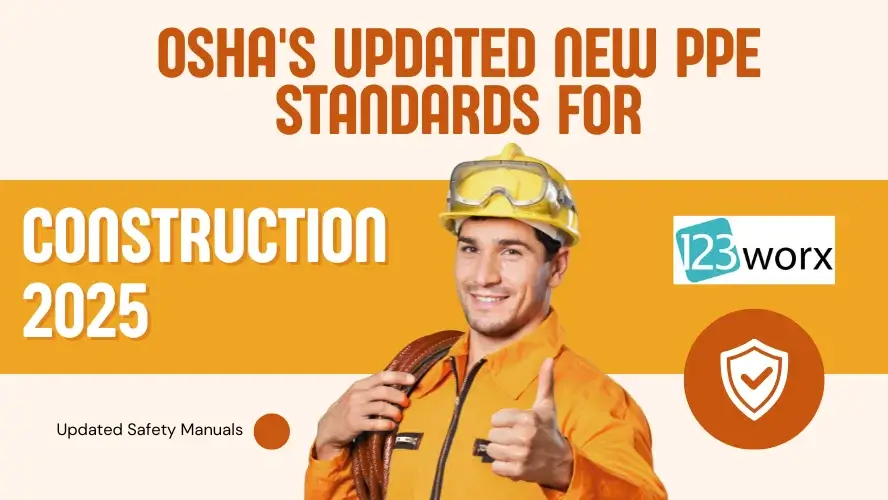Construction Sites and PPE: The 2025 Safety Revolution
Construction sites in the United States see over 150,000 accidents yearly. This alarming number makes safety protocols more important than ever before. The newest OSHA safety manual for construction brings the most detailed update to Personal Protective Equipment (PPE) standards we’ve seen in over a decade. These changes address our modern construction workforce’s evolving needs.The construction industry struggles with PPE implementation and compliance. OSHA’s updated construction safety manual PDF has expanded PPE requirements that work for workers of all sizes and backgrounds. The manual also accounts for specific job site hazards. These new construction PPE requirements will substantially change worker protection methods in construction sectors of all types – from homes to major commercial projects.OSHA Personal Protective Equipment (PPE) Standards Update for 2025
The U.S. Department of Labor announced the most important changes to the OSHA safety manual for construction, targeting Personal Protective Equipment standards. We received the final rule on December 11, 2024, which introduces explicit requirements for properly fitting PPE in the construction industry.Detailed Requirements for Properly Fitting Construction PPE
Employers must now ensure all protective equipment properly fits each worker who needs it. Several key requirements have emerged:- Safe design and construction for specific work tasks
- Proper fit selection for each affected employee
- Prevention of new hazards from ill-fitting equipment
- Workers’ diverse needs must be taken into account
Timeline for Implementation
These new standards will take effect on January 13, 2025. Construction employers now have time to evaluate their current PPE inventory and make needed adjustments. Our commitment to improving worker safety shows in this timeline that allows reasonable adaptation periods for industry compliance.Comparison with Previous Standards
Previous standards don’t match for the updated requirements. Construction PPE must now properly fit workers, a first-time explicit requirement that addresses a long-standing industry safety concern. These changes line up construction standards with existing general industry requirements.Women and physically smaller or larger workers face unique challenges with PPE size and fit. Improperly sized PPE creates additional hazards when oversized gloves or protective clothing get caught in machinery. Better comfort and fit will eliminate these risks and encourage consistent PPE use.Specific categories for PPE assessment now include employer-provided non-universal fit items, employee-purchased reimbursed equipment, and universal fit items. This clear categorization helps employers understand compliance requirements for different protective equipment types.How New OSHA PPE Rules Improve Safety for Construction Workers
The new PPE standards meet the needs of today’s diverse construction workforce. A recent informal survey showed that 77% of trades women faced unnecessary hazards because of ill-fitting PPE. These numbers highlight why we need to make these vital changes. To further support safety and efficiency, construction teams can explore essential apps for builders & contractors that simplify compliance and tracking processes.Inclusive PPE Standards for All Body Types in Construction
Construction workers have different body types and sizes. The new standards make PPE accessible to more people beyond just average-sized workers. Workers get these advantages:- Better workplace safety with properly fitted equipment
- More comfort that leads to consistent PPE use
- Lower risk of equipment-related accidents
- Better access to proper protective gear
OSHA PPE Fit Guidelines: Solving Size and Fit Challenges on Job Sites
Poorly sized PPE creates dangerous risks at construction sites. Oversized gloves or protective clothing can catch in machinery, and workers often skip wearing uncomfortable equipment. The new standards require employers to provide PPE that fits each worker’s unique body size and shape.Worker Safety Improvements
Properly fitting PPE makes a real difference in worker safety. Equipment that fits well protects workers better by eliminating dangerous gaps between gear and body. The updated requirements help prevent workplace accidents from equipment problems and boost overall safety compliance.Assistant Secretary for Occupational Safety and Health Doug Parker puts it clearly: “I’ve talked to workers in construction, particularly women, who have spoken of personal protective equipment that didn’t fit or was simply unavailable at the jobsite in their size”. These new standards ensure every construction worker gets PPE that actually protects them instead of creating new hazards.OSHA PPE Compliance Checklist for Construction Employers
The updated OSHA safety manual for construction outlines specific PPE compliance obligations for employers. This piece details everything employers need to know about worker safety and regulatory compliance.PPE Assessment Requirements
Employers must complete a detailed workplace hazard assessment to identify potential risks. The assessment helps determine if workers need PPE. Employers’ responsibilities during assessment include:- Choosing the right PPE types based on identified hazards
- Making sure equipment fits each worker properly
- Telling workers about PPE choices
- Getting written certification after completing the assessment
Documentation and Record Keeping
Construction PPE guidelines need proper documentation of all safety activities. Employers should keep written certification of hazard assessments that shows the assessed workplace, date, and certifier’s name. Records must include:- PPE training details
- Equipment inspection results
- Worker’s PPE requests
- PPE replacements and adjustments
Training Requirements
The manual outlines training protocols employers need before workers start PPE-required tasks. Workers must show they understand:- The right time to use PPE
- Their specific PPE needs
- The correct way to put on, remove, and adjust PPE
- Equipment’s limitations
- Care and maintenance steps
Common Challenges Construction Companies Face with New OSHA PPE Rules
The construction industry faces most important challenges with our new PPE standards implementation. Let’s get into the main obstacles and what they mean for employers and workers.Cost Considerations
Our analysis shows substantial financial impact on construction employers. OSHA estimates one-time costs of $5,475,450 and annual recurring costs of $279,065 for employers who don’t currently provide properly fitting PPE. A worker’s simple PPE costs include:- Hard hat: $8.20
- Safety gloves: $34.64
- Safety glasses: $6.20
- External metatarsal guards: $7.75
- Fall protection: $80.20
Supply Chain Implications
Manufacturers and distributors struggle with market demand predictions for specific product sizes and inventory cost management. Our supply chain worries focus on keeping adequate stock of PPE sizes and delivering them on time to construction sites. The industry must balance inventory control with proper fitting equipment availability for all workers. Leveraging the Critical Path Method in construction can help employers identify key tasks, allocate resources efficiently, and minimize delays in acquiring properly fitting PPE.Construction Industry Reactions to OSHA’s New PPE Standards
We’ve received substantial feedback about implementation hurdles. Construction industry stakeholders worry about unclear guidance on proper fit requirements. The standard’s broad definition creates confusion about compliance needs. Industry groups, including the National Association of Home Builders, want clarity on terms like “appropriate size” and “necessary protection”.The American Industrial Hygiene Association and National Institute for Occupational Safety and Health agree that the term “properly fits” gives simple guidance but lacks universal understanding. We address these concerns through continuous dialog with industry stakeholders and create additional implementation resources.OSHA Construction Safety Manual PDF
Download the updated OSHA construction PPE standards and compliance checklist. This summary includes implementation dates, new fit guidelines, and key inspection tips.OSHA Contractor Safety Requirements
Contractors must assess PPE hazards, enforce PPE rules among subcontractors, and maintain written documentation under OSHA 1926.20(b). This applies across all types of sites including commercial, residential, and infrastructure.OSHA General Contractor Responsibilities
General contractors are legally responsible for ensuring PPE compliance across the jobsite, coordinating between subcontractors, and keeping documented proof of training and distribution. This includes equipment checks and ensuring no worker is left without correct protective gear.OSHA General Industry Standards PDF
Compare OSHA General Industry (1910) and Construction (1926) standards in one downloadable PDF for reference [insert PDF link]. Helpful for dual-sector firms and safety managers.Frequently Asked Questions About OSHA PPE Requirements in Construction
Q1. What are the key changes in the updated OSHA PPE standards for construction?
With the updated rules, employers must guarantee each worker’s safety gear fits just right. They must consider not only the job-specific design, but also the exact size required, prevention against dangers of poorly-fitted equipment, and think about the unique needs of a varied workforce.Q2. When will the new OSHA PPE standards for construction take effect?
Changes in standards will happen on January 13, 2025. Construction employers have enough time to check their existing safety gear. They can then adapt to meet the new standards.Q3. How do the new PPE standards benefit construction workers?
The new standards help employees to boost safety at work by making sure equipment fits right. They also up comfort levels, which encourages regular use of safety gear. Plus, these rules cut down accidents related to equipment. And they make sure workers of all types get the right protective gear.Q4. What are the employer compliance requirements for the new PPE standards?
It’s crucial for employers to thoroughly check their workspaces for dangers. They need to pick the right protective gear based on this assessment making sure each worker’s gear fits right. Keeping records of these checks and gear training is a must. Finally, workers need detailed training on how to use their gear, keep it in good condition, and know its limits.Q5. What challenges do construction companies face in implementing the new PPE standards?
Putting plans into actions can be tough. There are big expenses involved. Imagine a one-time cost of $5,475,450 for the whole sector. Keeping a good stock of different PPE sizes might pose supply chain problems too. Plus, there’s a demand for clearer rules on what “proper fit” means for keeping within the rules.Q6. What is the most common OSHA violation in construction?
Fall protection remains the common OSHA violation in the construction industry, according to the most recent OSHA data.Q7. What is the OSHA standard for safety?
OSHA’s General Duty Clause (Section 5(a)(1)) requires all employers to furnish a workplace free from recognized hazards that can cause death or serious harm.Q8. What does OSHA require general construction areas to have a minimum of?
General construction areas must be illuminated to at least 5 foot-candles to ensure visibility and safety.Q9. Does OSHA set requirements for workplace safety?
Yes, OSHA enforces specific and general safety requirements through codes, inspections, and penalties.Final Thoughts on OSHA PPE Requirements for Construction Site Safety
The complete updates to our OSHA safety manual represent a major change to protect construction workers better with properly fitting PPE. Workers who faced problems with ill-fitting equipment will benefit from our new standards. Employers must now provide PPE in appropriate sizes and keep detailed records of documentation and training programs.Construction companies must overcome implementation hurdles. The one-time costs exceeding $5.4 million seem steep, but these investments will pay off through fewer accidents and better worker safety. Companies have until January 2025 to adapt their PPE programs and meet all updated requirements.These new standards will work best when employers, workers, and safety equipment manufacturers work together. Construction companies can direct these changes smoothly with clear communication and proper documentation systems. Every construction worker deserves protection, whatever their size or shape. Properly fitting safety equipment should protect them instead of creating new hazards.
As a Vice President at 123worx, Construction Management Platform, Bharat Rudra has worked with hundreds of business executives searching for best-suited software for their construction business with a wide array of requirements. Bharat takes pride in helping construction businesses solve their business and project management challenges. Feel free to reach Bharat if you have any questions. You can find him on LinkedIn or reach him at brudra@123worx.com


